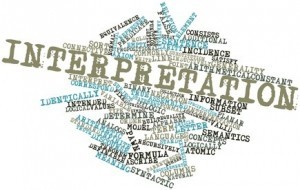There are two reasons for this misunderstanding: common opinion and marketers. There are some established but incorrect ways to call our profession, for example using the word translator instead of interpreter. These incorrect names are used by marketers or translation companies who – surprise, surprise – want to please search engines.
Let’s get the easiest incorrect ones out of the way first:
- Translator deals with written text. Interpreters only work orally. This is the greatest misunderstanding: these are two very different professions that require different skills. See our post: What is the difference between interpreter and translator: two distinct professions?
- real time interpreter or translating in real time: these are not technical terms and should not be used. There are no such terms as “live translation” or “real time translation” either. What is meant is simultaneous interpretation, when the interpreter is speaking at the same time with the speaker.
- a linguist is clearly different from an interpreter or a translator. It is usually a term used by the military or by marketers who want to attract a particular kind of crowd. For a more detailed explanation see our post: Why “Linguist” is not a Correct Term for “Interpreter”.
- instantaneous interpreter or interpretation: well, please, give is some time! It certainly takes more than an instant.
- sequential live interpreter/translator – what the speaker means here is “consecutive interpreter”: it is when the speaker makes a pause and the interpreter chimes in. But why is it incorrectly called “live”? We have no idea!
- speech interpreter: interpreters always work with spoken language, so the first word is redundant.
So what is correct terminology?
- interpreter (language interpreter) – it does not imply that oral interpretation is less accurate than written translation, it is just the title of a profession. For example, “George Brown is an interpreter” (not a translator.)
- simultaneous interpreter or consecutive interpreter refers to the mode of interpretation, but can also be the specialization, e.g. a “professional simultaneous interpreter”.
- The term “escort interpreter” (or sometimes “escorting interpreter”) is not universally used in all countries but it is a correct term too. Escort interpreters accompany delegations or clients on tours or to trade shows i.e. anywhere you need professional consecutive interpretation.
Interpreters come in different specializations as well: conference interpreter, court interpreter, medical interpreter, community interpreter.
- Conference interpreters (e.g. members of AIIC, International Association of Conference Interpreters) work primarily in the simultaneous mode. Many mostly work at various conferences and events and not in other settings. This specialization may require extensive travel, because your services may be needed worldwide.
- Court interpreters may be full time employees of courts of various jurisdictions or freelancers.
 They work in simultaneous mode during trials (usually with portable equipment) and consecutively during depositions, immigration interviews, attorney client meetings, and other events. They must have excellent command of legal terminology and know legal systems in the countries of their working languages.
They work in simultaneous mode during trials (usually with portable equipment) and consecutively during depositions, immigration interviews, attorney client meetings, and other events. They must have excellent command of legal terminology and know legal systems in the countries of their working languages.
- Medical interpreters are privy to confidential information that is exchanged between medical professionals and their patients. The specialization requires extensive knowledge of medical terminology and medicine (sometimes similar to that of a medical professional). It is also a very emotionally taxing field of work, and tact and bedside manner are an integral part of interpreter expertise.
- Public sector interpreters (more often called “community interpreters”) support various local governments, social or housing services, environmental health, education, and welfare services.
- Sign language interpreters work with sign languages. A sign language interpreter is a crucial link with the deaf or hard of hearing community.
Interpreters may also be classified based on their location: onsite or remote.
Onsite interpreter is physically present at an event or meeting.
- A remote interpreter is connected to a meeting by means of modern technology – an audio link, a video link or both.
 Almost all remote interpretation is in consecutive mode. Experiments with remote simultaneous interpretation started in the 1970s by the UN, however, even today there are no remote simultaneous interpretation systems that would be able to support ISO compliant sound quality required for this mode of interpretation. The technology is simply not there yet, despite various claims.
Almost all remote interpretation is in consecutive mode. Experiments with remote simultaneous interpretation started in the 1970s by the UN, however, even today there are no remote simultaneous interpretation systems that would be able to support ISO compliant sound quality required for this mode of interpretation. The technology is simply not there yet, despite various claims.
- Over the phone interpreters may work in a large call center or have private clients. Sound quality and good equipment is critical, as well as ability to interpret in a large variety of situations. The audio connection does not necessarily have to be over the phone, so the term “phone interpreter” is gradually becoming obsolete. A “remote interpreter” is less recognized but more technically accurate.
Video in conjunction with audio may be used by sign language interpreters or – more increasingly – community, court, and medical interpreters. The problem is again of audio and video quality: a professional video conferencing system is required. Attempting to make interpretation over Skype or similar consumer grade technologies is a road to disaster. Visual input is extremely important to understand context and meaning.
 As you can see, interpreters come in all different flavors and colors, just take your pick! What matters though is hiring standards: you should pick the right ones. Read our post about hiring standards and how to choose best interpreters for your project. How Clients May Hire the Best Language Interpreters and Evaluate Quality of Simultaneous and Consecutive Interpretation?
As you can see, interpreters come in all different flavors and colors, just take your pick! What matters though is hiring standards: you should pick the right ones. Read our post about hiring standards and how to choose best interpreters for your project. How Clients May Hire the Best Language Interpreters and Evaluate Quality of Simultaneous and Consecutive Interpretation?


